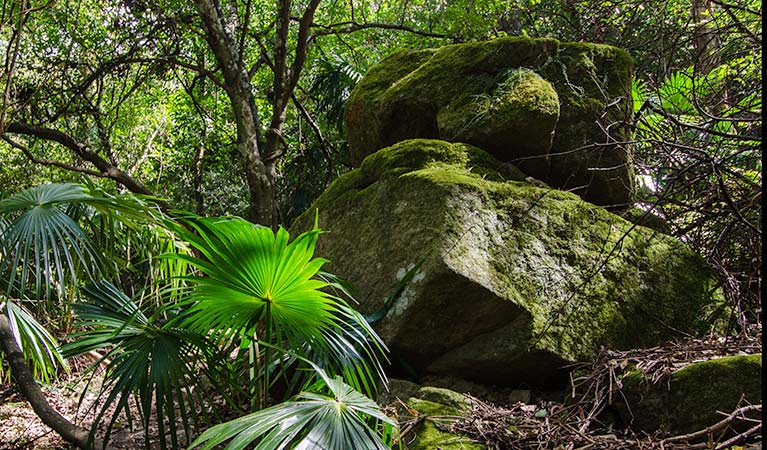Illawarra Escarpment State Conservation Area
Overview
Framing Wollongong, the Illawarra Escarpment is a dramatic 30 million-years-old formation, offering scenic lookouts, hiking, walking, birding, and picnic spots.
Read more about Illawarra Escarpment State Conservation Area
Millions of years in the making, the Illawarra Escarpment State Conservation Area features dramatic sandstone cliffs and a medley of different forest types, from sub-tropical rainforest to olive-green eucalypts and towering cedars. Throw in two accessible mountains, an abundance of colonial and Aboriginal heritage, and a stunning variety of birdlife, and you have a unique place with attractions to suit any taste.
Come for a serious bushwalk or a casual jog, visit a lookout in the winter for whale watching off the coast, or break out the binoculars for birdwatching. There are cycling opportunities on fire trails and plenty of chances to cool off in summer by retreating to a rainforest track. The area is also popular with families taking advantage of the picnic spot by firing up barbecues on Sundays.
And while the Conservation Area is just a stone’s throw away from Wollongong, once you’re surrounded by its natural beauty, you’ll feel entirely removed from the hustle and bustle of city living.
Local alerts
For the latest updates on fires, closures and other alerts in this area, see https://www.nationalparks.nsw.gov.au/visit-a-park/parks/illawarra-escarpment-state-conservation-area/local-alerts
Contact
- in the South Coast region
Illawarra Escarpment State Conservation Area is always open but may have to close at times due to poor weather or fire danger. However, it is recommended that bushwalking only be undertaken during daylight hours because of the presence of cliff edges and other hazards.
-
-
Wollongong office
02 4224 4188
Contact hours: Monday to Friday, 8.30am to 4.30pm. - Unit G Ground Floor, 84 Crown Street, Wollongong NSW 2500
-
Email: npws.illawarrahighlands@environment.nsw.gov.au
-
Wollongong office
Visitor info
All the practical information you need to know about Illawarra Escarpment State Conservation Area.
Map

Map legend

Getting there and parking
Get driving directions
From Sydney:
- Drive south along the Princes Highway. Exit at Helensburgh for Stanwell Park, Sublime Point for the Sublime Point Track, or at Figtree for Mount Keira.
From Stanwell Park:
- Drive south (1km) along Lawrence Hargrave Drive to the start of the Forest Walk
From Wollongong:
- Drive west along Mount Keira Road to Byarong Park at Mount Keira, or via Cordeaux Road to Mount Kembla.
Please note: There is no access to Illawarra Escarpment State Conservation Area from Brokers Nose and Brokers Point via Hawthorn Street, as this is private property.
Parking
- Byarong Park picnic area See on map
- Robertson lookout See on map
By bike
Check out the Bicycle information for NSW website for more information.
By public transport
Illawarra Escarpment State Conservation Area is accessible by train from Sydney via the Cityrail South Coast Line to Stanwell Park, Coalcliff, Austinmer or Wollongong.
For information about public transport options, visit the NSW transport info website.
Best times to visit
There are lots of great things waiting for you in Illawarra Escarpment State Conservation Area. Here are some of the highlights.
Spring
Enjoy a native wildflower display on the Forest walk.
Summer
Cool your heels on the Mount Keira ring track, which threads through refreshing rainforest.
Winter
Take advantage of the escarpment elevation for a spot of whale watching north of Mount Keira, or from one of the several lookouts.
Weather, temperature and rainfall
Summer temperature
Average
16.5°C and 25.6°C
Highest recorded
42.3°C
Winter temperature
Average
8.3°C and 18.3°C
Lowest recorded
-0.5°C
Rainfall
Wettest month
April
Driest month
August
The area’s highest recorded rainfall in one day
316mm
Facilities
Toilets
Picnic tables
Barbecue facilities
Drinking water
Maps and downloads
Prohibited
Pets
Pets and domestic animals (other than certified assistance animals) are not permitted. Find out which regional parks allow dog walking and see the pets in parks policy for more information.
Smoking
NSW national parks are no smoking areas.
Nearby towns
Wollongong (9 km)
There are plenty of opportunities for adventure activities in and around Wollongong ranging from surfing and swimming to sailing, hang gliding, paragliding, cycling and abseiling. Wollongong is the only place in NSW where you can skydive onto the beach.
Stanwell Park (32 km)
Stanwell Park is a small coastal town with a glorious surf beach. It's set dramatically against the steep, forested escarpment cliffs.
Sydney City Centre (107 km)
No trip to Sydney is complete without spending some time in the city’s beautiful parks. Whether it’s in central areas like Hyde Park or the Royal Botanic Gardens or further out in Centennial Parklands, there’s plenty of green space to go out and enjoy.
Learn more
Illawarra Escarpment State Conservation Area is a special place. Here are just some of the reasons why:
Weekend city escape
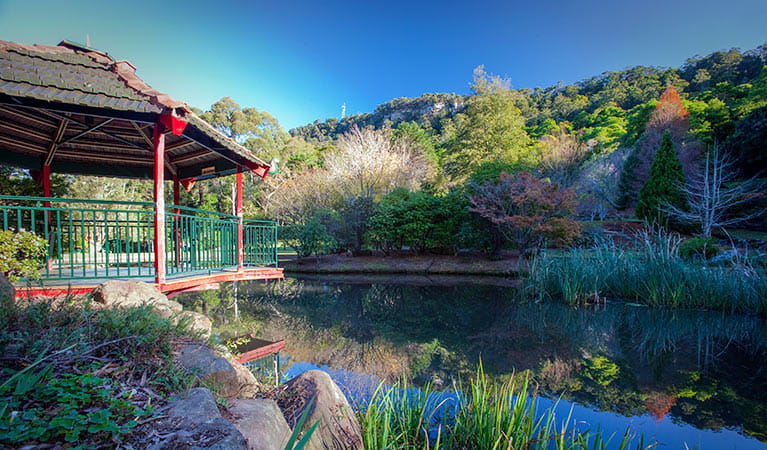
Illawarra Escarpment State Conservation Area's convenient proximity to the city and public transport options means it has become an important venue for sports and recreation - on weekends it buzzes with hikers, picnickers, and cyclists.
- Byarong Park picnic area Easily accessible and featuring all the facilities needed to enjoy a barbecue, the popular Byarong Park picnic area also offers walking track access and birdwatching.
- Robertson lookout The most scenic views of Mount Keira can be found at Robertson’s lookout, and tables make this a terrific picnic spot as well.
Our colonial past
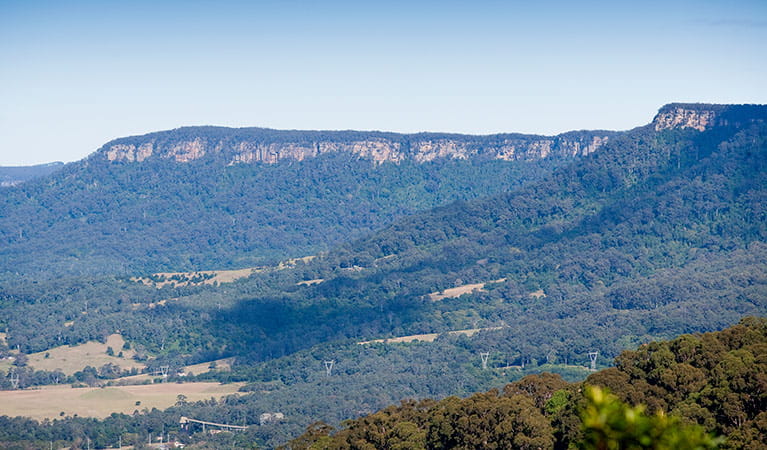
The Illawarra Escarpment area is full of important local heritage, including colonial roads like the ones constructed by Surveyor-General Thomas Mitchell around 1834. Some were even built by convicts. Keep your eyes open for buildings, portals, rail tracks and other features from former farming and coal mining.
- Mount Keira Ring track Encircling Mount Keira, the ring track passes through the varied terrains and forests of the Illawarra Escarpment, starting and finishing in a perfect picnic spot.
How it all began
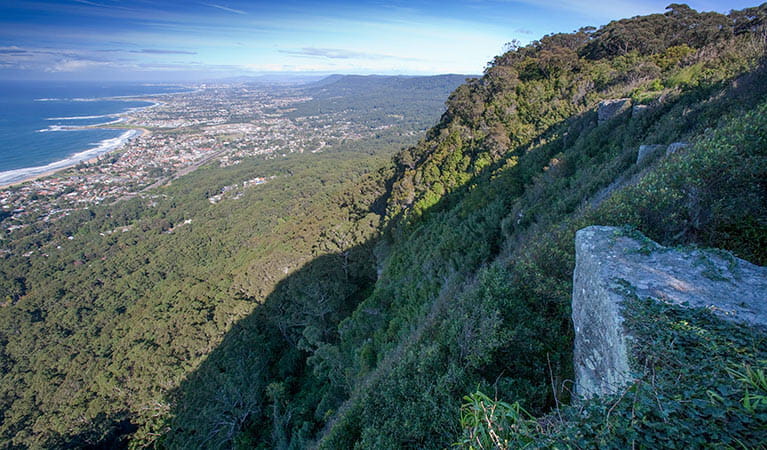
The Illawarra Escarpment lands were occupied by the Wodi Wodi Aboriginal people for 20,000 years. As such, they are a source of cultural legends and of continuing spiritual significance: Mount Kembla and Mount Keira, for example, feature in a number of creation stories. The conversation area also contains traditional routes of travel between the coastal plain and the plateau.
- Mount Kembla Ring track Taking in a significant Aboriginal site, local heritage, stunning scenic rainforest and a notable landmark, the Mount Kembla Ring track offers a taste of everything.
Going bush
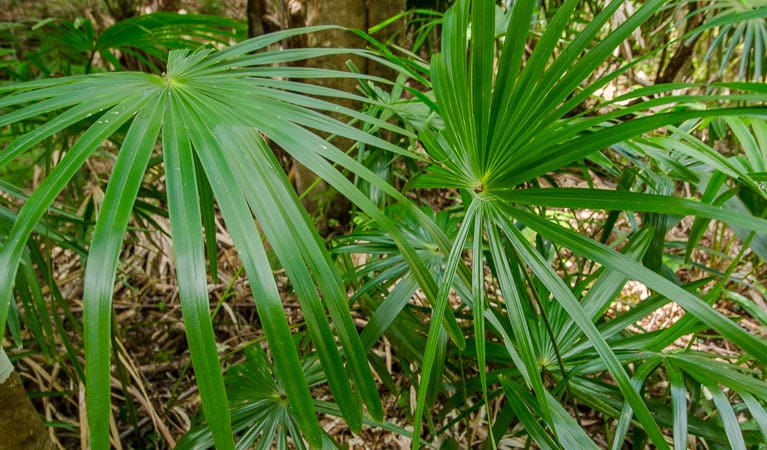
The Illawarra Escarpment contains the most extensive area of rainforest in the Sydney basin and forms a crucial corridor between Royal National Park and the South Coast. The area acts as an important refuge for species that are affected by environmental disturbances such as development and bushfires. There are currently 12 threatened animal species in the area. You might even spot a lyrebird, the wildlife emblem of the National Parks and Wildlife Service.
- Bush school and nature playgroups in Illawarra Do you want to ignite your child’s passion for the natural world? Join a fun, nature-based program run by Bush Magic Adventures in the Illawarra Escarpment State Conservation Area, near Wollongong.
- Byarong Park picnic area Easily accessible and featuring all the facilities needed to enjoy a barbecue, the popular Byarong Park picnic area also offers walking track access and birdwatching.
- Forest walk to Sublime Point track Combining several hiking tracks, this extended day walk is one of the region’s best, taking in scenic views of the coast and Sydney, with access to nearby forest picnic spots.
200 million years and counting
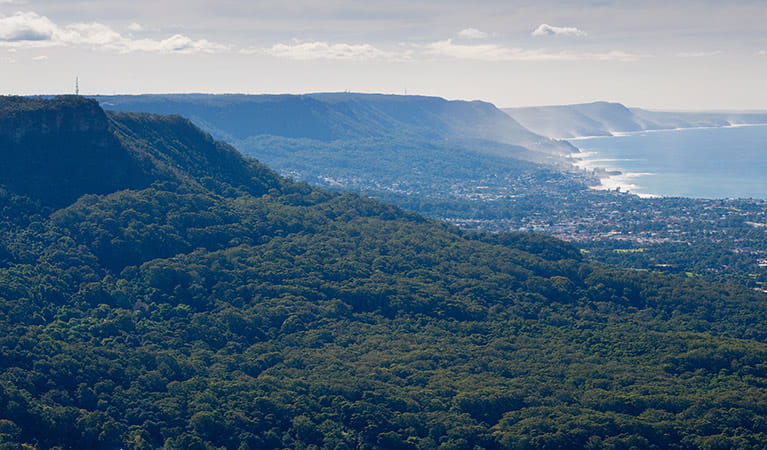
The 500-metre-high Illawarra Escarpment provides a dramatic backdrop to the city of Wollongong and spans 200 million years of geological history. The escarpment is so notable, it's currently listed as a 'Scenic Landscape of State-wide Significance' on the Register of the National Trust of Australia (NSW).
- Bush school and nature playgroups in Illawarra Do you want to ignite your child’s passion for the natural world? Join a fun, nature-based program run by Bush Magic Adventures in the Illawarra Escarpment State Conservation Area, near Wollongong.
- Forest walk to Sublime Point track Combining several hiking tracks, this extended day walk is one of the region’s best, taking in scenic views of the coast and Sydney, with access to nearby forest picnic spots.
- Mount Keira Ring track Encircling Mount Keira, the ring track passes through the varied terrains and forests of the Illawarra Escarpment, starting and finishing in a perfect picnic spot.
- Sublime Point walking track For a challenging walk through rainforest, Sublime Point walking track offers great birdwatching and scenic views across Illawarra Escarpment State Conservation Area.
Plants and animals protected in this park
Animals
-

Superb lyrebird (Menura novaehollandiae)
With a complex mimicking call and an elaborate courtship dance to match, the superb lyrebird is one of the most spectacular Australian animals. A bird watching must-see, the superb lyrebird can be found in rainforests and wet woodlands across eastern NSW and Victoria.
-
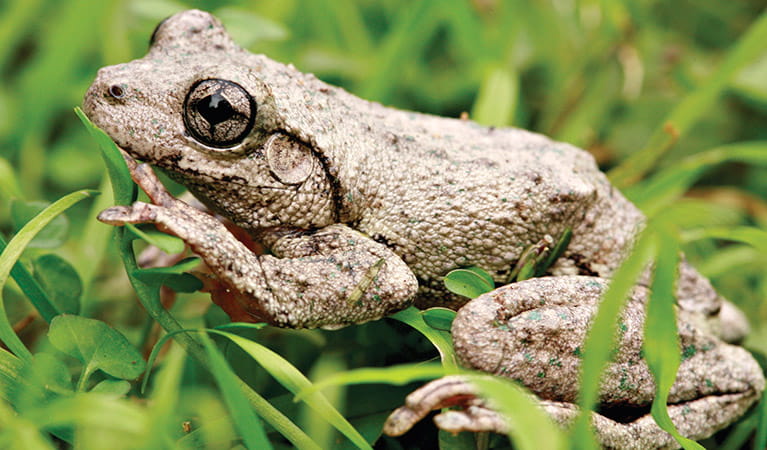
Peron's tree frog (Litoria peroni)
Peron’s tree frog is found right across NSW. These tree-climbing and ground-dwelling Australian animals can quickly change colour, ranging from pale green-grey by day, to a reddish brown with emerald green flecks at night. The male frog has a drill-like call, which has been described as a 'maniacal cackle’.
-
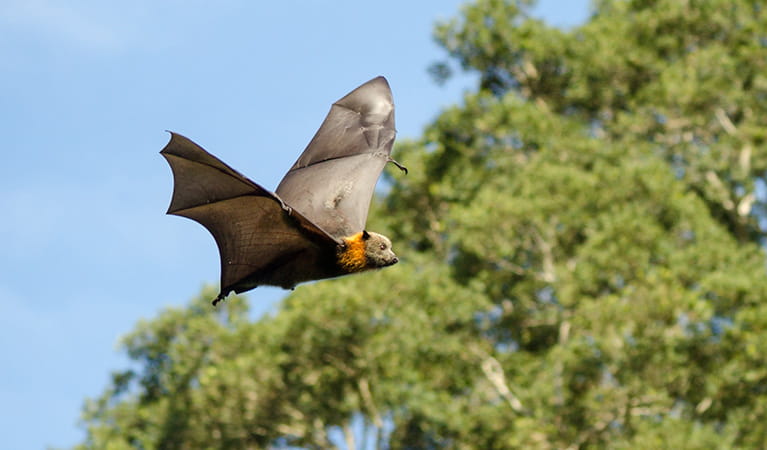
Grey-headed flying-fox (Pteropus poliocephalus)
The grey-headed flying fox is Australia's largest native bat, with a wingspan up to 1m. This threatened species travels up and down south-eastern Australia and plays a vital role in pollinating plants and spreading seeds in our native forests.
Education resources (1)
What we're doing
Illawarra Escarpment State Conservation Area has management strategies in place to protect and conserve the values of this park. Visit the OEH website for detailed park and fire management documents.

